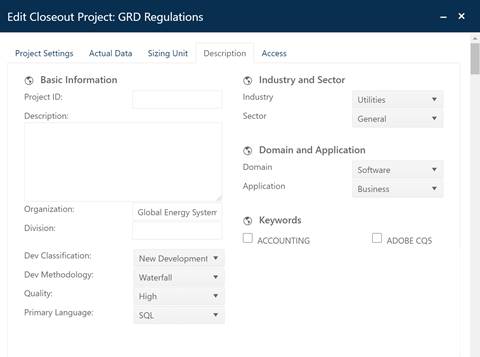
Description tab settings are used to document important project characteristics and classify or select projects with similar characteristics for calibrating estimates and benchmarking completed projects. Depending on the option used to create the project, some fields may be pre-populated with default values from a source project or template. These fields are primarily descriptive in nature. Thus, most do not affect the calculation of management metrics like PI (productivity index), schedule, effort, or reliability.

•Project ID. An optional alphanumeric identifier for the project.
•Description. Provides additional contextual information about the project.
•Organization. The company or entity that was responsible for the project.
•Division. Business unit responsible for the project.
•Dev Classification. Select the classification that best represents the proportion of new code delivered by the current release:
o New Development - > 75% new function
o Major Enhancement - 25 to 75% new function
o Minor Enhancement - 5 to 25% new function
o Conversion - < 5% new function
o Maintenance
•Dev Methodology. Select the method that best describes the process used to plan and control the project. Note: this field has no counterpart in SLIM-Estimate. Development Methodology data for Closeout projects exported to SLIM-DataManager will be written to the Development Paradigm Custom Metric field.
•Quality. Choose the label that best describes your confidence in the accuracy and consistency of this project’s data:
o Low - Low Confidence (error > 10%)
o Moderate - Moderate Confidence (5% > error < 10%)
o High - High Confidence (error < 5%)
•Primary Language. Select the primary language used for product construction and coding.
•Industry/Sector. Select the industry and sector that best represents your project. This field is used for documentation and analysis purposes to allow you to sort projects into similar groupings.
•Domain/App Type. The domain and application type allow you to sort projects by complexity or type. The predominant application type field specifies the application type most heavily represented in the system. Application type is tied to the Domain field, the available selections will change depending on the Domain selected. For example, the Software Domain has nine QSM default primary application types. Choose the domain and application type that best describe the project:
o Microcode & Firmware. Software that is the architecture of a new piece of hardware or software that is burned into silicon and delivered as part of a hardware product. This software is the most complex because it must be compact, efficient, and extremely reliable.
o Real Time. Software that must operate close to the processing limits of the CPU. This is interrupt driven software and is often written in C, ADA, or Assembly language. Typical examples are military systems like radar, signal processors, missile guidance systems, etc.
o Avionics. Software that is on-board and controls the flight and operation of the aircraft.
o System Software. Layers of software that sit between the hardware and applications programs. Examples include operating systems (Windows, Android, iOS, Chrome OS, Linux, Ubuntu, etc.), Executives or Data Base Management systems, Network products, and Image processing products.
o Command & Control. Software that allows humans to manage a dynamic situation and respond in human real-time. Examples are battlefield command systems, telephone network control systems, government disaster response systems, military intelligence systems, and electric utility power control systems.
o Telecommunications. Software that facilitates the transmission of information from one physical location to another. Examples are telephone switches, transmission systems, modem communication products, fax communication products, and satellite communications products.
o Scientific. Software that involves significant computations and analysis. Examples are statistical analysis systems, graphics products, and data reduction systems.
o Process Control. Software that controls an automated system. Examples are software that runs a nuclear power plant, or software that runs a petro-chemical plant.
o Business. Software that automates a common business function. Examples are payroll, personnel, order entry, inventory, materials handling, web projects, and warranty products.
•Keywords. Keywords allow you to define one or more descriptive terms used to sort, filter, classify or group projects in the main Project List view. The Keywords field is designed to make it easier to quickly tag projects with one or more relevant project characteristics, then use those tags to sort or filter project records on the Project List page in SLIM-Collaborate. For Closeout projects exported to SLIM-Suite desktop applications, keywords can be used to select relevant groups of projects for analysis or trend line creation in SLIM-Metrics. Keywords allow you to create more “freeform” project classifications that are tailored to your data collection and analysis needs. The list of keywords you see here is determined by the site administrator. If you don’t see the keyword you need, contact your site administrator and ask to have a new keyword added to the list.